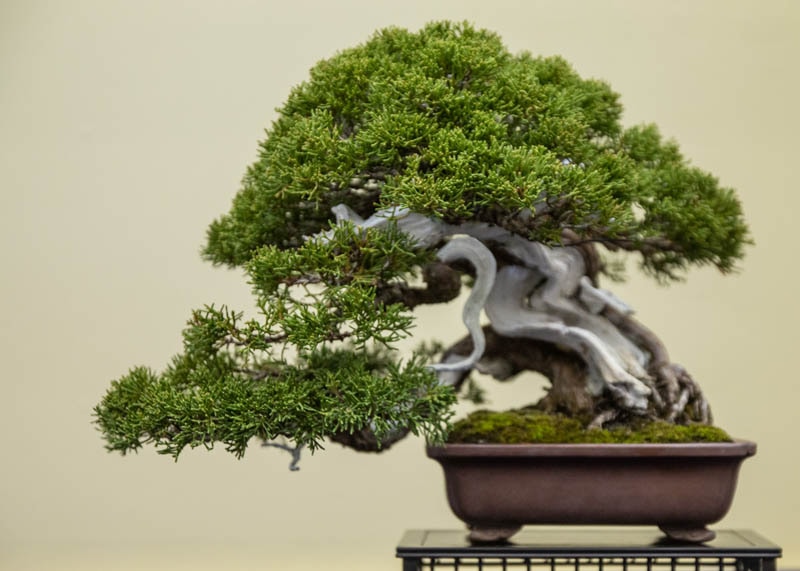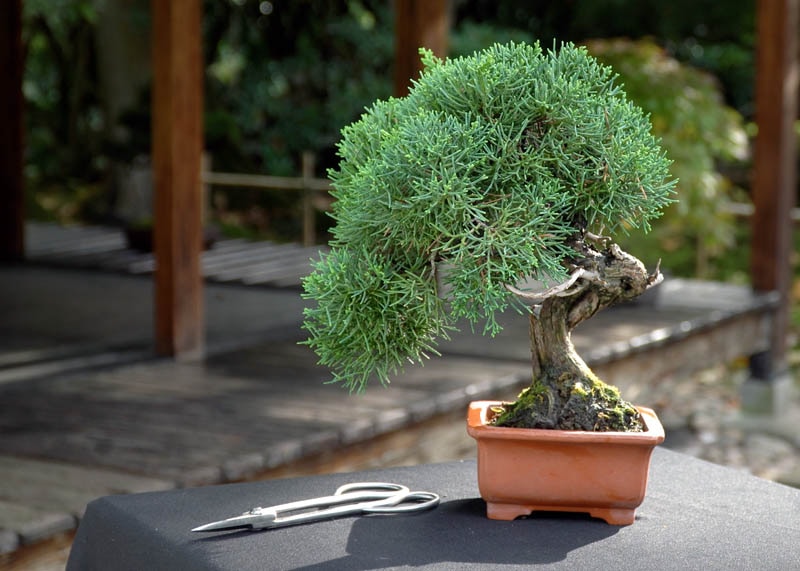Chinese Juniper bonsai trees need regular pruning and proper sunlight. Water the soil when it starts to dry out.
Chinese Juniper bonsai trees are popular for their elegant appearance and resilience. These bonsai trees thrive with adequate sunlight, preferably in a location that receives direct sunlight for several hours a day. Pruning is essential to maintain the tree’s shape and health.
Ensure to water the tree when the topsoil feels dry to the touch, but avoid waterlogging. Fertilize the bonsai during the growing season to promote healthy growth. Repotting every two to three years helps manage root growth. With proper care, Chinese Juniper bonsai trees can become a beautiful and enduring addition to any bonsai collection.

Credit: www.bonsaiempire.com
Introduction To Chinese Juniper Bonsai
Chinese Juniper Bonsai trees thrive with proper care, offering a stunning visual appeal. Ensure regular pruning, adequate sunlight, and well-drained soil for optimal growth.
Origins And History
The Chinese Juniper is a popular bonsai tree. It originated from East Asia. This tree has been cherished for centuries. Ancient Chinese and Japanese cultures admired it. These trees symbolize strength and protection.
Unique Characteristics
Chinese Juniper bonsai trees have needle-like leaves. They are evergreen, staying green all year. Their bark is reddish-brown and flaky. These trees are very resilient. They can survive in various climates.
Choosing The Right Juniper Bonsai
Chinese Juniper Bonsai trees thrive with proper care. Ensure adequate sunlight, well-draining soil, and regular pruning for optimal growth.
Selecting A Healthy Tree
Pick a tree with bright green leaves. Avoid trees with yellow or brown leaves. Check for pests and diseases. Look at the roots. Healthy roots are white and firm. The trunk should be strong and thick. A good tree has lots of branches. The tree should have a nice shape.
Ideal Varieties
Some good varieties are Shimpaku, San Jose, and Blue Star. Shimpaku is very popular. San Jose is good for beginners. Blue Star has lovely blue-green leaves. All these trees are easy to care for. They grow well in most climates. They also respond well to pruning.
Optimal Growing Conditions
The Chinese Juniper bonsai needs bright light. Place it in direct sunlight for 4-6 hours daily. Avoid dark or shaded areas. Indoor growing is fine with adequate light. Rotate the plant for even light exposure.
Keep the bonsai in temperatures between 50-75°F. It prefers moderate humidity levels. Use a humidity tray if indoor air is dry. Avoid exposing the plant to cold drafts. Protect it from extreme heat.
Watering Techniques
Proper watering techniques are essential for Chinese Juniper Bonsai tree care. Ensure the soil is moist but not waterlogged, and water thoroughly when the topsoil feels dry.
Frequency And Amount
Water the Chinese Juniper Bonsai tree every day. Ensure the soil is moist but not soggy. Check the top inch of soil. If it feels dry, it’s time to water. Use a watering can with a fine nozzle. This helps to avoid soil erosion. Always water the tree in the morning. This allows the soil to dry before night.
Best Practices For Watering
Use room temperature water for your bonsai tree. Cold water can shock the roots. Warm water may promote bacteria growth. Ensure good drainage in the pot. Never let the tree sit in water. This can cause root rot. Mist the leaves occasionally. This helps to increase humidity. Avoid watering the foliage directly. This can lead to fungal infections.
Pruning And Shaping
Use sharp scissors and a small saw. Trim branches to shape the tree. Prune in late winter or early spring. Pinch new growth with fingers. This helps maintain the bonsai’s shape. Be careful not to remove too much. Always cut above a leaf node. This promotes healthy growth.
Spring is the best time to prune. The tree is ready to grow. Summer pruning is also okay. It helps control growth. Avoid pruning in fall. The tree is preparing for dormancy. Winter is not ideal for pruning. The tree rests during this season. Always consider the tree’s health.
Soil And Repotting
The best soil mix for Chinese Juniper Bonsai trees is well-draining. Use a mix of akadama, pumice, and lava rock. This mix helps the roots breathe and prevents waterlogging. Good drainage is crucial for healthy growth. Add some organic matter to retain moisture. Avoid soil that holds too much water. It can cause root rot.
Repotting should be done every two years. Spring is the best time to repot. Carefully remove the tree from its pot. Trim the roots with clean scissors. Place the tree in a new pot with fresh soil mix. Ensure the tree is stable in its new home. Water the tree well after repotting. Keep it in a shaded area for a few weeks. This helps the tree recover.
Fertilizing Your Bonsai
Proper fertilizing ensures healthy growth for your Chinese Juniper bonsai. Apply balanced fertilizer during the growing season to maintain vibrant foliage. Regular feeding supports root development and overall tree vitality.
Types Of Fertilizers
Use an organic fertilizer for your bonsai. Liquid fertilizers are easy to apply. Slow-release granules provide nutrients over time. Choose a balanced fertilizer with equal parts of nitrogen, phosphorus, and potassium. Avoid high-nitrogen fertilizers as they can damage the tree. Look for bonsai-specific fertilizers for the best results.
Application Schedule
Fertilize your bonsai during the growing season. Spring and summer are the best times. Reduce the frequency in fall. Stop fertilizing in winter. Apply liquid fertilizers weekly. Use slow-release fertilizers once a month. Always follow the instructions on the package. Over-fertilizing can harm your bonsai.

Credit: www.youtube.com
Pest And Disease Management
Aphids, spider mites, and caterpillars often attack the Chinese Juniper Bonsai. These pests suck the sap or chew the leaves. They can weaken the tree and cause damage. You might also see scale insects. They attach themselves to the branches and suck the tree’s juices.
Keep your bonsai tree healthy and clean to avoid pests. Regularly inspect the leaves and branches for signs of pests. Use a gentle spray of water to remove pests. Neem oil can be a natural deterrent. Ensure proper air circulation around the bonsai tree.
Winter Care
Frost can damage your Chinese Juniper Bonsai. Cover the tree with a frost cloth. This will keep it warm. Avoid watering the tree at night. Water can freeze and harm the roots. Move the tree to a sheltered spot if possible. A garage or shed works well.
Indoor storage keeps the tree safe from extreme cold. Place the tree near a window for sunlight. Outdoor storage is also an option. Use a cold frame or greenhouse to protect it. Check the temperature regularly. Ensure it stays above freezing.

Credit: www.bonsaiempire.com
Advanced Techniques
Master advanced techniques for Chinese Juniper bonsai care to ensure healthy growth and stunning aesthetics. Prune regularly, provide ample sunlight, and maintain proper watering schedules.
Grafting And Propagation
Grafting helps to create a stronger bonsai. It joins parts of two plants. This helps improve growth and shape. Cut a branch from a healthy tree. Attach it to another tree. Use tape to hold it in place. Water the tree regularly. This helps the graft heal faster.
Creating Deadwood Features
Deadwood features add an ancient look to your bonsai. Use a sharp tool to create deadwood. Remove bark from certain areas. Carve the wood to make it look old. Apply lime sulfur to the deadwood. This helps preserve it. The tree looks more dramatic and aged.
Conclusion
Caring for a Chinese Juniper Bonsai tree is rewarding and therapeutic. Proper watering, pruning, and sunlight are essential. Regularly check for pests and diseases to ensure health. With patience and dedication, your Bonsai will thrive and become a beautiful addition to your home.
Enjoy the journey of nurturing this unique and elegant tree.

